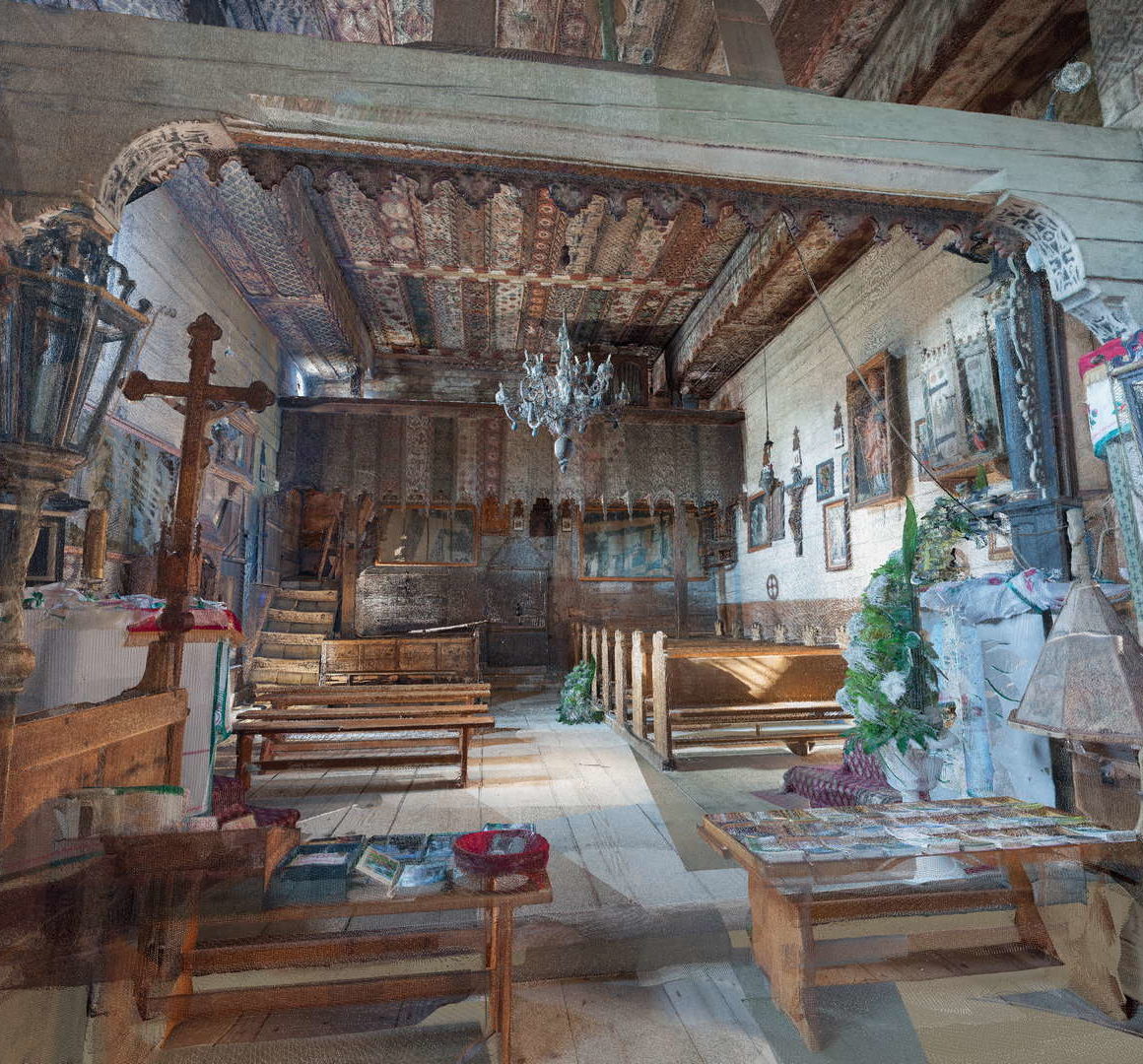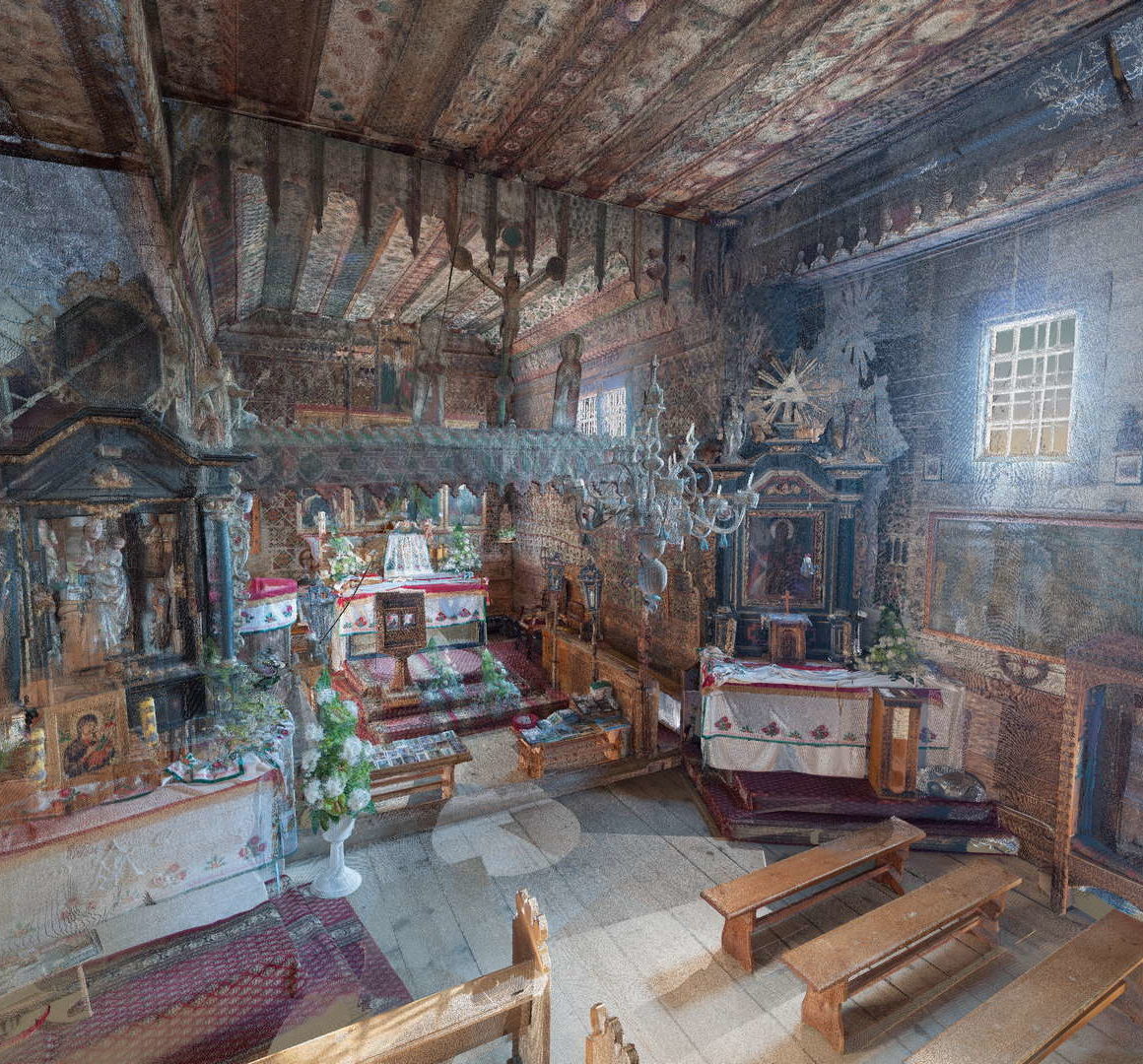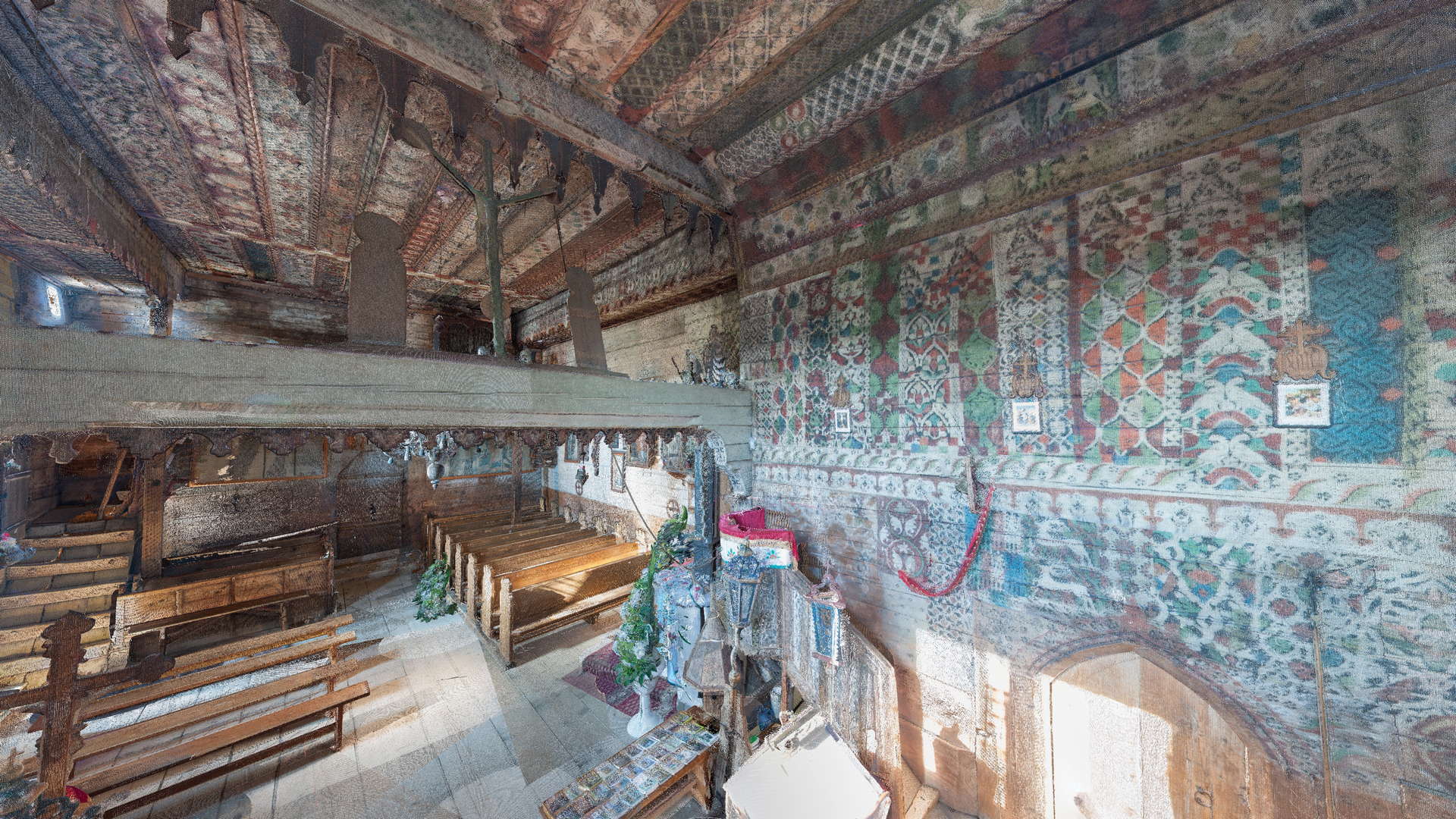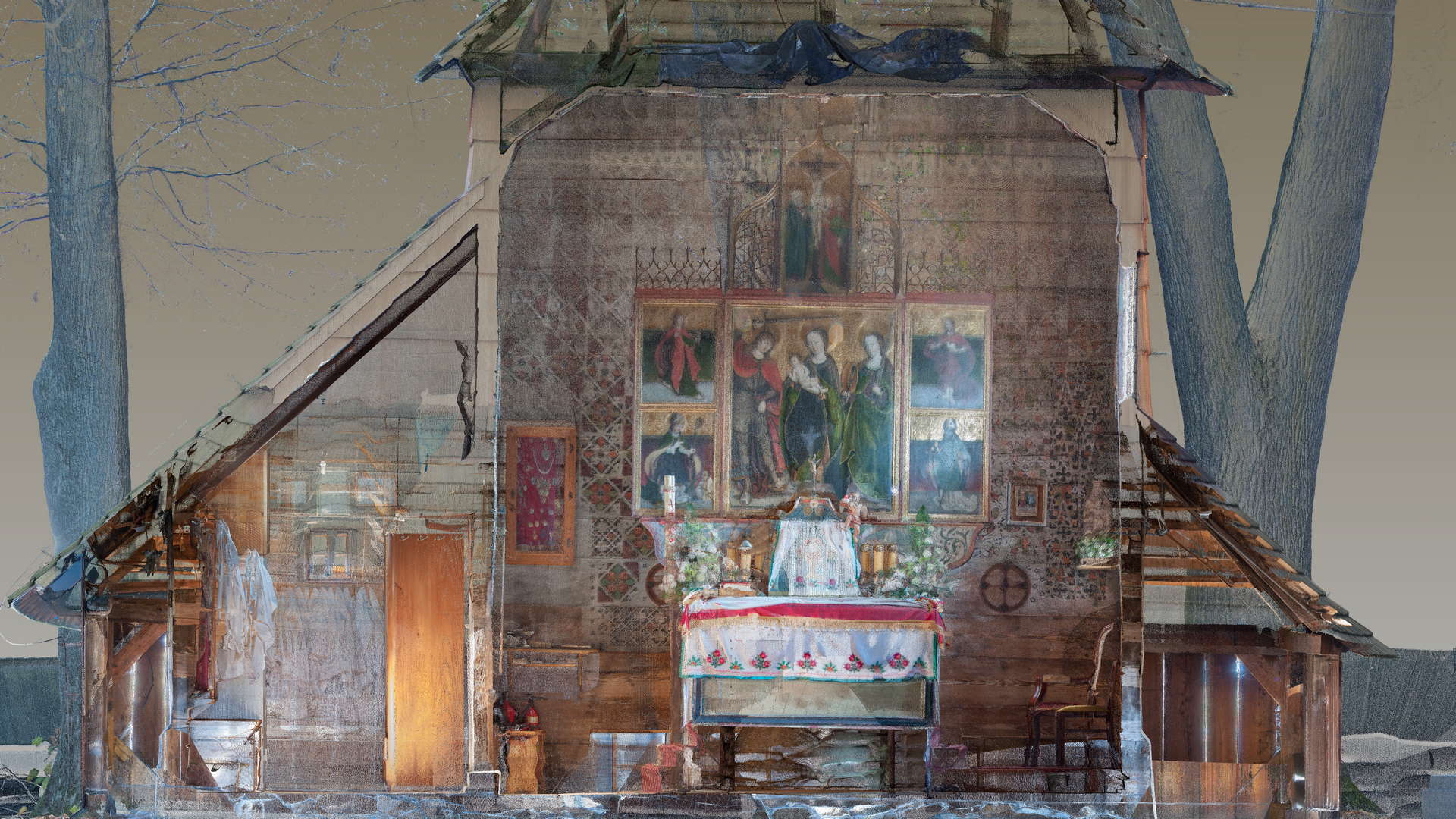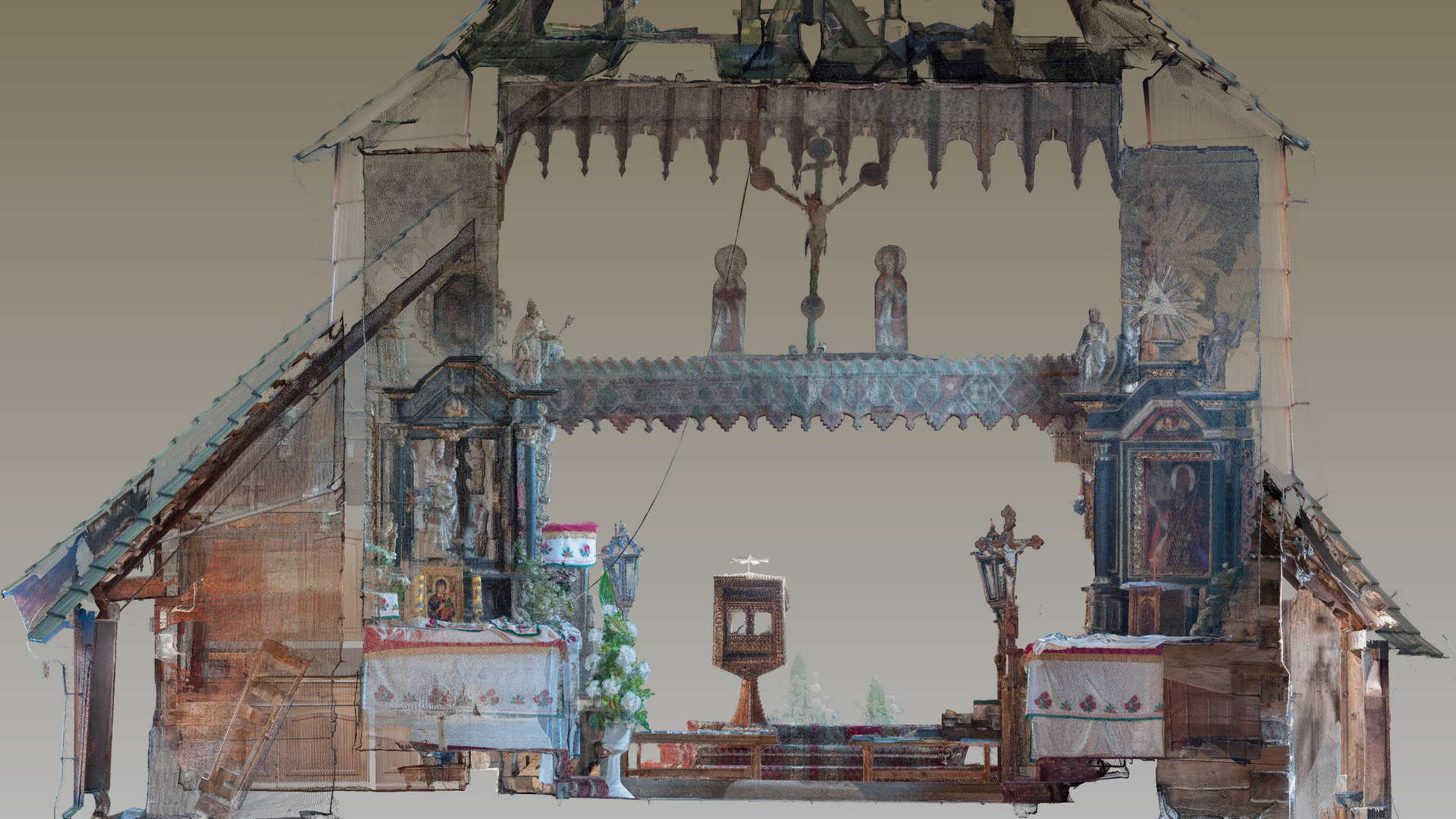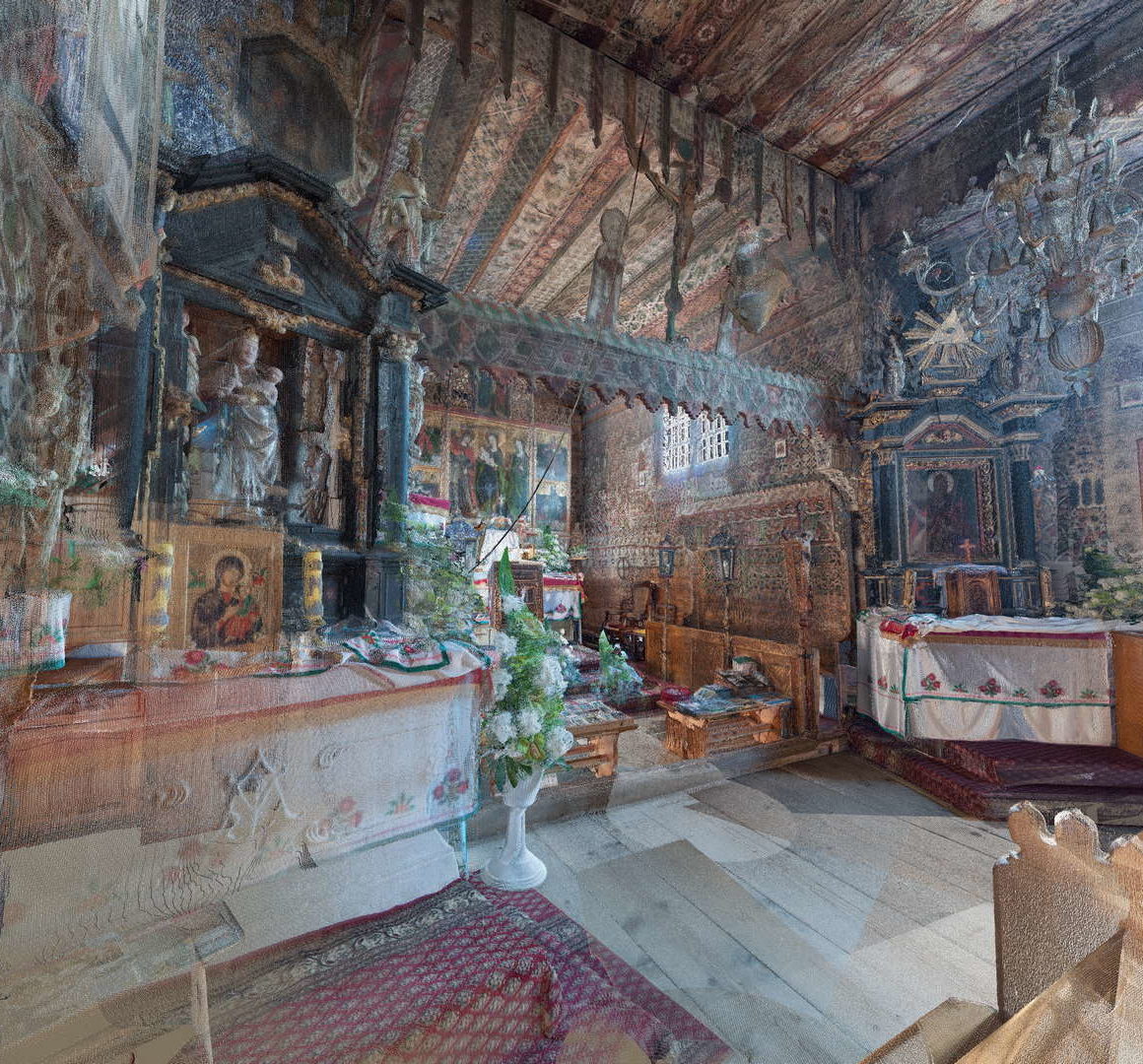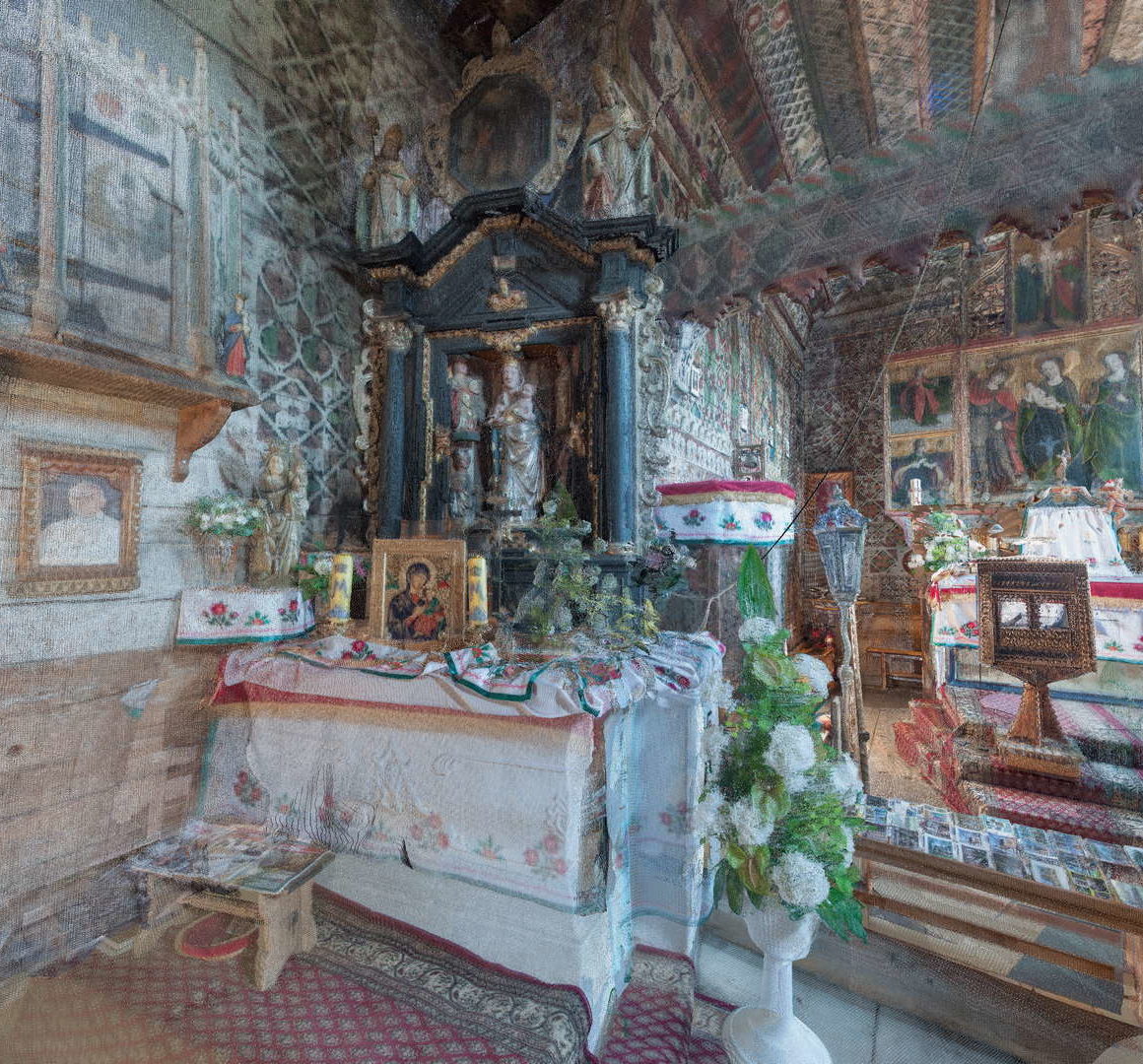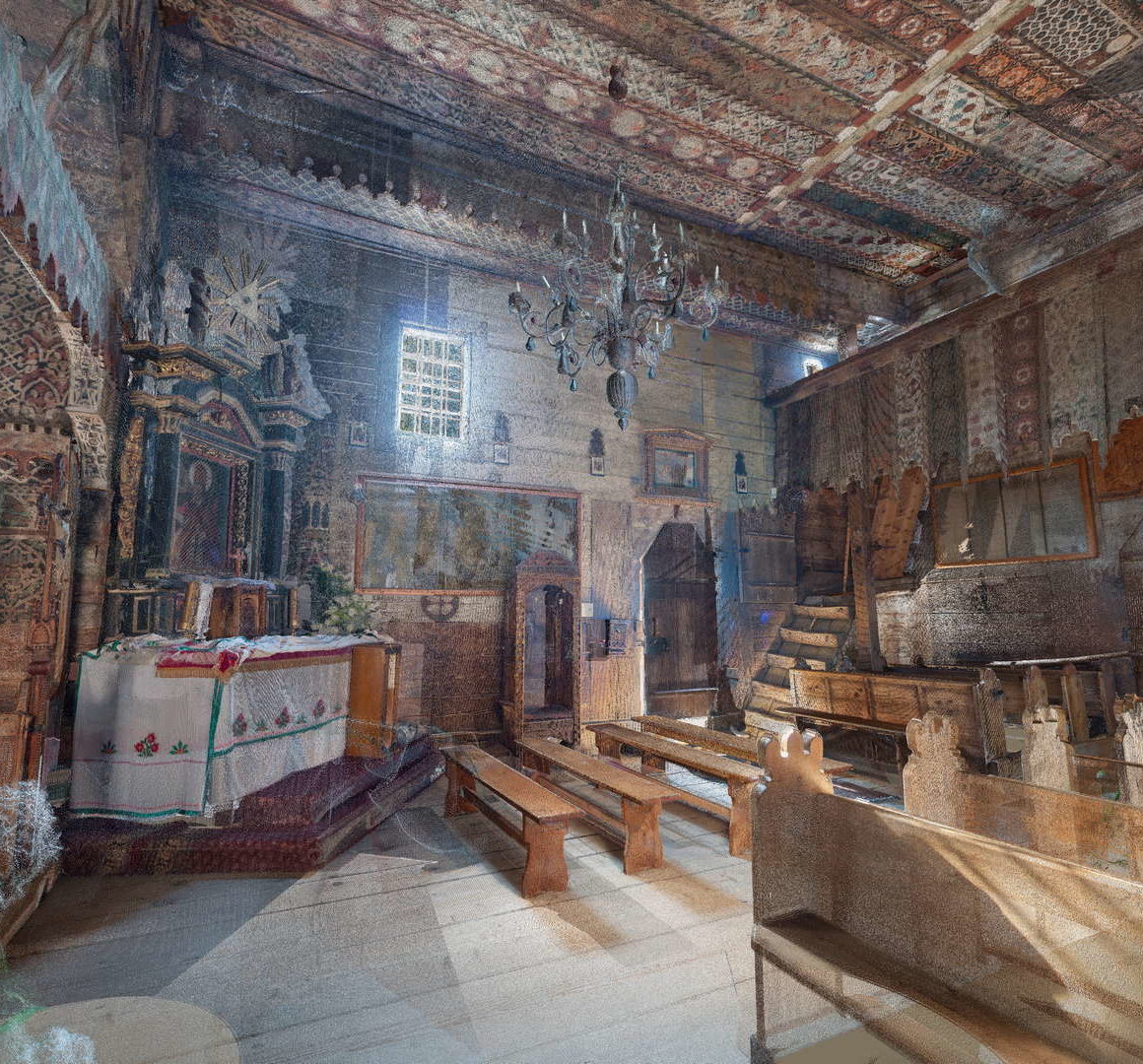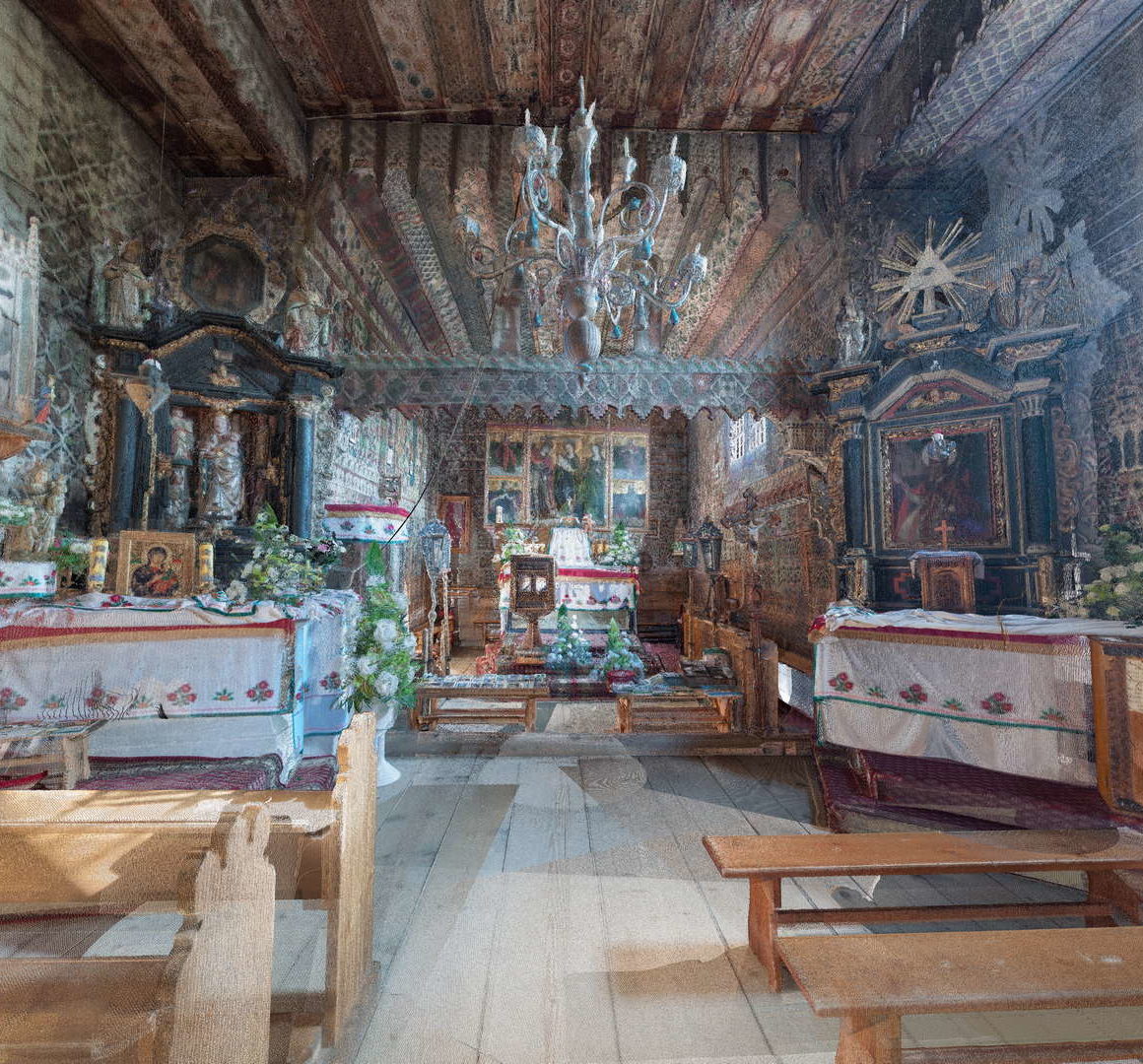Dębno – St. Michael the Archangel Church.
Copy of the so-called “Saints of Dębno”
NOn the northern wall of the church in Dębno, there is a small rectangular plaque with an image of two saints; it is a copy of the so-called “Dębno board”, with the original currently in the Archdiocesan Museum in Kraków. In the autumn of 1949, when the roofed arcades of the church were being repaired, a board with the painted figures of two saints was found. The small board, only 68.5 x 23.5 cm, was removed from the arcades and placed on one of the side altars. A few days later, the church was visited by art historians, Tadeusz Dobrowolski and Józef Dutkiewicz, who immediately noticed the previously unknown painting. They thought it was a remnant of a late Roman painting from the late 13th century; today, it is believed that “Saints of Dębno” dates back even earlier, to the 1270s or 1280s.
The two holy women depicted here are dressed in tunics and overclothes and are holding palms in their hands, symbolising martyrdom. The remaining inscriptions over the heads of the saints say that they are St. Catherine and St. Agnes. This is almost certainly part of a larger composition (maybe an altarpiece) depicting saints surrounding the enthroned Virgin and Child.
The Dębno panel is usually referred to as a late Romanesque relic as the painting does contain features that we usually associate with the Romanesque style: the figures are shown in a simplified way, the forms are flat and geometrised and have a distinctive contour. At the same time, however, the angular folds of the characters’ clothing may be associated with the style of German painting of the 3rd quarter of the 13th century, characterized by geometrised drapery and called Zackenstil (from German, “Zig-zag Style”).
One of the saints from the Dębno panel is making a courtly gesture of supporting the overcoat belt, characteristic of the depictions of beautiful women in Gothic cathedrals (including statues of the Wise Virgins from the Cathedral of Magdeburg from around 1250). The Saints of Dębno are therefore not fully associated with the traditions of the earlier Romanesque art, but also include references to the contemporary 13th-century Gothic art.
It is hard to say where the Dębno painting was created, with it usually being assumed that it came from Krakow, although some researchers associate it with Spisz. Interestingly, the oldest preserved Lesser Poland relics of panel painting, not counting the panel from Dębno, date from the beginning of the 15th century, although there are mentions of paintings from the 14th century. The guild of painters in Krakow was founded before 1404, but paintings had definitely been created there earlier; we can actually assume that artists had been active in Krakow in the 13th century. It was at that time when Lesser Poland (the term is here understood as a historical region, which mostly coincides with the area of former Western Galicia, much larger than the present voivodeship) started to play a dominant role in shaping Polish culture. During the period of fragmentation of Poland (high Middle Ages), Kraków gained its status as the most important centre for the lands ruled by the Piast princes.
Rood beam.
A rood beam was a structural reinforcement of the so-called chancel arch, which divided the nave from the chancel. In medieval churches, the latter, reserved for the clergy and the mass celebration, was separated from the area used by the congregation with a choir rail. The custom of putting a crucifix on the beam emerged from the ancient tradition of placing the Holy Cross altar in the middle of the church.
The crucifix from the rood beam of the Dębno church dates back to the late 14th century, which means it was created much earlier than the current temple. It might be a preserved interior element of the previous church in Dębno, since the local parish had already existed in the 1st half of the 14th century. The crucified Jesus was depicted dead: his head lowered and eyes closed, and there is a visible bleeding wound in his side, which the perpetrators inflicted upon the Saviour after his death. The cross on which Christ hangs does not look like a simple form made of beams, but is rather shaped like a tree: the arms spread to the sides at a slight angle, like branches, and the entire cross is green and covered with bud-like extensions. The cross has the form of the so-called “Tree of Life” (Latin: Arbor Vitae). Medieval authors juxtaposed the Tree of the Cross with the Paradise Tree: the forbidden Paradise Tree brought sin and death, while the Tree of the Cross gave humanity life and redemption. The concept of the cross as a tree of life became particularly popular after the 13th century, which was largely influenced by the texts of St. Bonaventure, who compared the Cross of Christ to a blossoming tree.
The next century saw an increase in popularity of the so-called mystic crucifixes which emphasized the suffering aspect of the crucified Christ: his body was depicted as emaciated and covered with blood clots, while the arms of the Y-shaped cross reinforced the impression of the tormented body hanging on the cross.
The ends of the arms of the Dębno cross have four medallions: three of them contain preserved painted figures of Apocalyptic beings, identified with the symbols of the Four Evangelists. They were also interpreted as a personification of the four corners of the world or, more generally, of all the creations that take part in the Act of Redemption. The Cross was understood not only as an instrument of torture, but mainly as the Throne of Glory of Jesus, shown as the ruler of the universe. Medieval theologians also interpreted the Apocalyptic beings as personifications of various aspects of the Person of Christ: power (lion), sacrifice (ox), or victory and freedom (eagle). The Apocalyptic beings surrounding Christ can also traditionally refer to biblical creatures that can be found in the descriptions of God’s revelation (animals of the Apocalypse, and beings from the Book of Ezekiel).
Currently, the rood beam contains the entire Crucifixion group: on the sides of the medieval crucifix, there are figures of the Virgin Mary and John the Evangelist painted on contoured boards. They were, however, added later, maybe in the 17th century.
Tabernacle
The church in Dębno houses a group of unique late-Gothic pieces of furniture, including a pulpit, font cover, bench, and tabernacle. It is not a tabernacle from the main altar, but rather a wooden cabinet intended to be secured to the adjacent wall. In the Middle Ages, the Host was initially kept in the sacristy or in “cabinets” hidden in the chancel wall; over time, it became a custom to build decorative structures, called sacraria. However, they were not elements of the altarpiece. The change took place following the decisions of the Council of Trent (1545-1563); according to the post-conciliar instructions, the Blessed Sacrament was meant to be kept in a tabernacle secured in the main altar.
Reforms introduced by the Council of Trent, which played a significant role in changing the equipment of churches, were related to the Counter-Reformation; the clergy decided to place greater emphasis on developing the cult of the Eucharist. As a result of those provisions, over time, most churches adapted their equipment according to the new instructions of the Church authorities, while removing the old elements. The pre-conciliar late-Gothic tabernacle, unrelated to the structure of the altarpiece, is therefore a truly unique item.
Side altars
The side altars come from the 17th century; the predella of the altar by the north wall, next to an atmospheric nativity scene, includes the date ‘1661’ (not 1651, as some publications say). The central part of the altar, on the other hand, shows Gothic figures of the Virgin and Child and Saints Catherine, Barbara, Cecilia, and Dorothea (2nd quarter of the 15th century). They are the remains of the so-called Four Virgins’ Altar, i.e. an altarpiece whose middle part showed the image of the Virgin and Child surrounded by four smaller figures of Holy Virgins (early Christian martyrs).
The other side altar contains a painting that depicts the Holy Pope; it might be St. Gregory the Great or St. Urban. Interestingly, in 1611, St. Urban was mentioned as the second patron saint of the church in Dębno, but later his cult in this temple slowly disappeared. The remains of the older side altar survived in the form of a shrine (the middle part of the triptych) containing a figure of St. Nicholas, dating from the 1st quarter of the 15th century. The sloping side walls of the shrine show painted figures of Early Christian deacons, depicted with instruments of their passion: St. Lawrence with a gridiron (he is said to have been roasted on a gridiron) and St. Stephen with stones (he was stoned).
Fun fact: bells.
The chancel houses old bells, commonly known as chimes. It is highly unlikely that they come from medieval times as some guidebooks suggest, let alone from the 5th century (they are more likely to date from around the 19th century)! Meanwhile, such information about the church in Dębno can be found in many publications (especially online). The mistake may have started with a typo: someone once may have “lost” the Roman numeral ‘X’ when copying the date from a text which incorrectly suggested that the bells had come from the 15th (XV) century.
Fun fact: saved by… being forgotten?
The late-medieval elements of decoration and equipment from the church in Dębno have survived there for centuries. It is possible that they have avoided being replaced by ‘the updated models’ thanks to the fact that the church in Dębno gradually lost its significance in modern times. In the 16th century, parish priests from Dębno resided in other villages (in Harklowa and Maniowy) and, in 1630, Dębno lost its status as a parish and was incorporated into the parish in Maniowy. In the 18th century, masses were celebrated here only every third Sunday. This gem of Podhale monuments was not “discovered” by the researchers until the mid-19th century.


